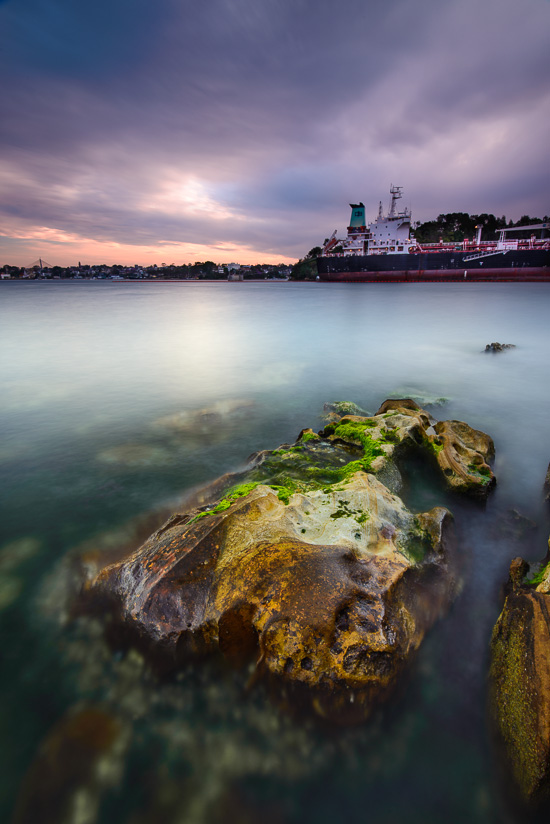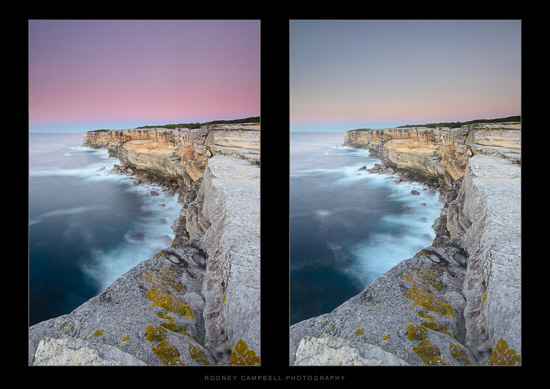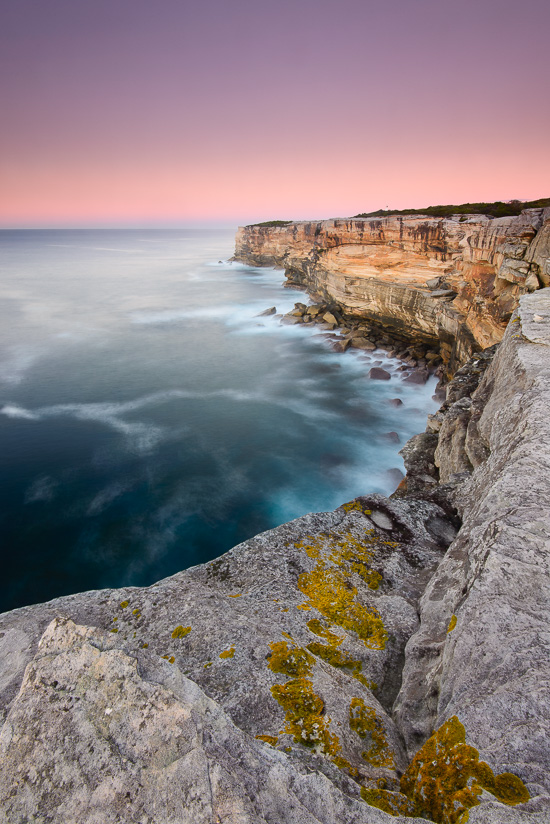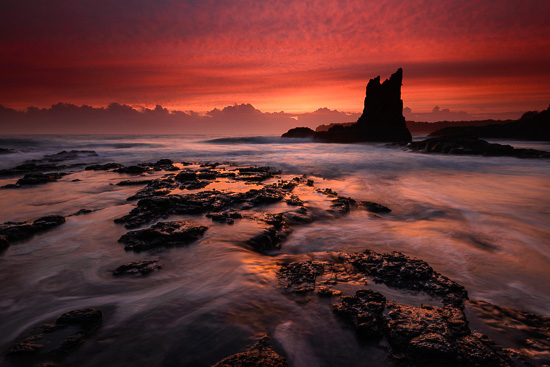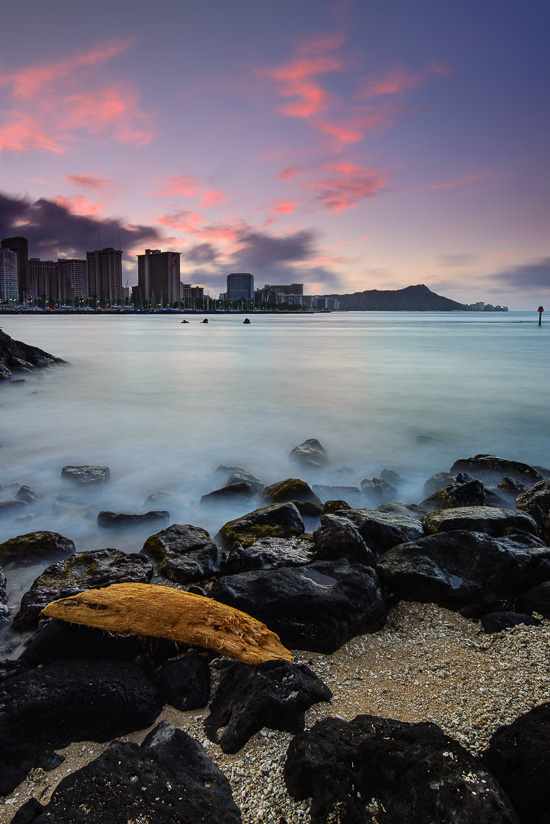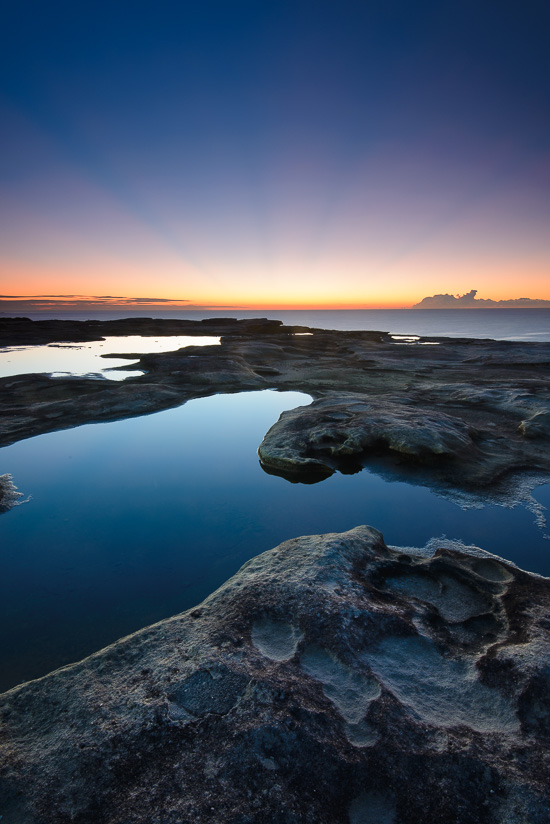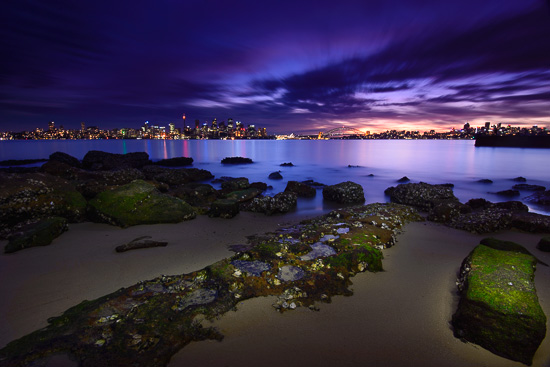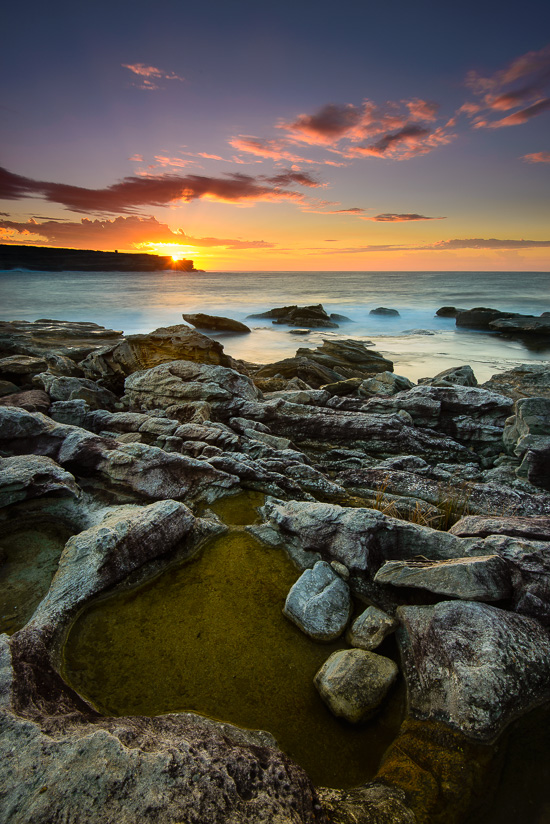Review: Formatt-Hitech 0.9 Reverse GND…
by Rodney Campbell on Jul.16, 2014, under Life, Photography
So what is all the fuss about with these Reverse Graduated Neutral Density Filters – read on and see what I think about one of my current favourite sunrise and sunset landscape filters – the Formatt-Hitech Neutral Density Reverse Grad 0.9 (3 Stops)
Otherworldy Light
For a number of years now I’ve been an extremely happy user of the Slot in Lee 100mm Filter System
Starting with the Foundation Kit, with the Filter Holder (with up to 3 slots) and a 77mm wide-angle adapter ring and a single Lee 0.9 (3 stop) Hard Graduated Neutral Density Filter (or Lee 0.9 Hard ND Grad for short) – this has been my constant companion on trips around Sydney and around the world, along with my ultra wide angle (currently the Nikon AF-S 16-35mm f/4G ED VR) and standard telephoto (currently the Nikon AF-S ED 24-70mm f/2.8G) lenses
Over time I’ve added things like a Lee 0.6 Hard ND Grad (2 stop) and a Lee 105mm front filter ring and my most expensive filter the absolutely awesome Heliopan 105mm Slim Circular Polariser SH-PMC Filter. I also have the very useful but fairly specialised Lee BigStopper (a 10 stop neutral density filter)
Note: These images (especially the wider shots) look much better when larger – so click any of the images below to see larger versions in an inline overlay slideshow gallery viewer.
A Bit of Background
The reason landscape photographers use Neutral Density filters is for two main reasons
– we use solid ND filters to lengthen shutter speeds – ND filters cut down the amount of light coming through the lens into our cameras – ideally in a “neutral” way (i.e. evenly across the visible light spectrum and thus not causing any unwanted colour shifting or colour casting) and also by a fixed amount (generally indicated in the number of stop of light reduction – e.g. 1 (0.3), 2 (0.6), 3 (0.9), 4 (1.2), 6 and 10 stops
Some examples of when we might use these types of filters is to be able to lengthen shutter speeds when shooting moving water (waterfalls, oceans, rivers and so on) or moving clouds or in fact any moving objects (sometimes just to remove those objects from our scene). Other times photographers want to shoot with a wider aperture than the normal bright ambient light allows
– we use Graduated ND filters to try and balance larger contrast differences across parts of the scene
Basically cameras cannot see and record the same range of brightness that the human eye can. When the sun is low in the sky or just over the horizon there is generally a much wider tonal range than the camera can capture. In essence the sky is really bright and the land is really dark in comparison and this range of brightness between the sky and land is beyond what a camera can capture – either the sky is over-bright (or completely blown out) or the land is extremely dark (or black) or both
A Graduated ND filter is toned with a darker area at the top of the filter and a clear area on the bottom half. The darker area is neutral and holds down the exposure over the sky portion of the scene whilst allowing the bottom half (the land) to expose normally. The idea here is to create a more evenly exposed single image with good detail and colour in the sky and a lot more detail in the foreground
Aside: Technically these days photographers can use multiple exposures of the scene (taken at different exposure settings – e.g. -4EV, -2EV, 0EV, +2EV, +4EV) and post processing techniques (HDR tone mapping, blending multiple exposures on layers using tools like luminosity masking, etc) to achieve the same result
Personally I’m a bit lazy and I’d rather spend a few minutes more in the field getting the filters and the exposure just right at capture time rather than spending hours post processing an image on the computer – I’m a very strong proponent of getting as much right as I can in camera. I believe this has other side benefits as well – including making me slow down and be a lot more patient and selective when taking the images which I also believe has made me a much better photographer with stronger compositions
I’d been using this basic filter kit for quite a while however I had been interested in getting and trying what is known as a reverse grad for some time. To understand why I’ll go into a little about the different types of grad filters
Teaching Point: A tip for others using the rectangular based slot in filters (e.g. 6×4″/150x100mm or other similar systems) – if you have hard grad filters you don’t necessarily need to also purchase the expensive solid ND filters – I just pull the hard grad filter right down so the ND portion covers the whole frame. Even on a full frame camera at 16mm I find the slightly less than half of the 150×100 grad which is a solid ND coating is enough to cover the whole frame
Graduated ND Filters
I mentioned above that solid ND filters come in various strengths. Graduated ND Filters (ones which have a neutral darker area on one half and are clear on the other half) also come in various strengths. Commonly in 1 (0.3), 2 (0.6), 3 (0.9) and 4 (1.2) stop variants but sometimes others as well but in addition they also vary in the way the transition area (between the clear part of the filter and the coloured (neutral density) part of the filter)
As a general rule, a hard grad would be used for images containing a horizon, or any hard transition between the sky and the foreground – even with jagged or mountainous horizons, the exposure can be controlled far easier with a hard grad. This is because the transition between the clear and ND part of the filter is fairly quick (note that it isn’t by any means an instantaneous hard line)
Soft grads perform best in woodland, mist, or interiors. Anywhere where there is no definite transition between sky and foreground, a soft grad will gently balance exposure across the image. The transition area of this filter is quite broad and in fact it transitions over from clear to ND over a much wider area so the area around the middle of the filter is quite weak. Because of this soft grads can be more difficult and less effective when used on crop cameras, lenses with a smaller diameter and telephoto lenses
One problem when shooting sunrises and sunsets is that the horizon is normally the brightest area of the scene, with the soft filter this can actually be the weakest part of the ND area and the sky can easily burn out in this part of the scene (which forces most people to drag the filter down way too low – darkening the rest of the scene). This is less of a problem with hard grads as the horizon area of the filter is much darker and because of this it is more effective
Still however it’s this transition area of both soft and hard grads which is the weakest area of the ND grad filter and thats generally the area you put onto the horizon of your scene. Another thing which tends to also happen at these times of day is that the upper sky is quite a bit darker than near the horizon so when you shoot with a regular ND grad and expose for the brightest part of the scene (the horizon) the top of your image in the upper sky ends up being even darker because thats the part of the filter which is the strongest
Reverse Grads
So wouldn’t it be great to have an ND grad filter which was strongest in the middle and then got gradually weaker as it moved up to the top of the filter…
As it happens a few filter makers have listened and have produced what are called Reverse Graduated Neutral Density Filters (or Reverse Grads for short)
Singh-Ray pioneered the way with their excellent but extremely pricey reverse grads. This was a bit rich for my blood and as Lee don’t as yet make any Reverse Grads I opted instead to try another British filter maker – Formatt-Hitech and their reverse grad (the subject of this review)
I would have liked a four stop (1.2) reverse grad however the strongest one that Formatt-Hitech make is the 3 stop (0.9)
I’ve now been using this filter for about 9 months and so far I’ve been extremely impressed and I seriously don’t know what I’d do without it now
My Thoughts
First up I’ll list what some people might consider some of the negatives
The Formatt-Hitech filters are slightly thinner than the Lee filters – it still stays in the filter holder without any issues but I can tell it isn’t quite as thick as the Lee grads both by feel and because it slides more easily in the holder slots. In practice this isn’t a problem at all but just in case you need to know
The filters come in a plain plastic wallet – nothing like the very nice padded cases that the Lee filters come in. This isn’t a problem if you have a separate filter pouch – but it does appear to be common with the other filter manufacturers like Formatt-Hitech, Kood & Cokin. Personally I would not keep the filters in this plastic wallet because I’m sure they would easily scratch over time going in and out. I keep my multiple filters in the very nice Lee Filter Wrap and then in the Lee pouches
Like the Lee grad filters I own it is made from optical resin (and not glass) – which I like because they are lighter and less prone to breaking when bumped, dropped or slightly bent but they are apparently more prone to scratching – I’ve used mine for many years without issues
On my copy of this filter the transition line in the middle of the filter is slightly off perpendicular to the side edges of the filter – whereas my Lee filters are for all intensive purposes exact. What this means is that I have to rotate the filter (either the whole holder or the filter in the holder) ever so slightly to get it right – this is only a problem if I’m stacking grad filters and thus need the transition lines to be parallel and it really is very very slight – it’s not like it’s diagonal across the filter or something
Lastly it’s not colour neutral when stacked with other filters. With the Lee filters I generally find I can stack them with other Lee filters and the Heliopan CPL without undue colour casting or shifting. When using the Formatt-Hitech 0.9 Reverse ND Grad stacked with other filters there is a definite colour shift
Personally I usually like the effect this filter gives me in this regard. I can’t explain it exactly but it is like it gives a slight but noticeable colour boost and even a slight punchiness to the image (almost like you’re using a polariser) but it’s an effect I generally like. There are scenes however where you don’t want this colour shift (in the area covered by the filter) and then of course it’s a problem 🙂
Here is an example of two shots taken less than 2 minutes apart – the first using the Formatt-Hitech 0.9 Reverse ND Grad stacked with a Lee 0.9 ND and then the second a Lee 0.6 ND Grad stacked with the same Lee 0.9 ND. It’s not exactly a fair one to one comparison since I probably should have been comparing with the Lee 0.9 grad so I’ve had to slightly adjust the exposures in post to more readily match the overall exposures of the two scenes but the rest of the processing, white balance and so on has been synchronised between the two images
Whilst this is probably the most extreme example of this that I’ve seen myself it does show that there can be a noticeable difference in the results when stacking different filters (especially from different manufacturers)
Hitech Reverse Grad vs Lee Grad
Lest you think that the sky colour change is just due to the natural colour changes in the sky happening very quickly just before sunrise (which it was) – the following image was taken after the stacked Lee shot above (4 minutes after) – I’d switched back to the reverse grad because I liked the results I was seeing on the camera LCD better
Sweet Dreams
In practice this filter is a joy to use and does pretty much what it’s designed to do. It’s clear to see the difference between shots taken with say this 3 stop reverse grad and the standard 3 stop Lee grad at sunrise or sunset. The detail retained at the bright horizon along with the subtle tones and details retained in the upper sky – be it clear sky or clouds and colours are readily apparent
The one major potential problem when using the reverse grad is that anything that seriously breaks the horizon, be it some headland, a mountain, a building or tree is going to get very dark very quickly because the darkest part of the reverse grad is right at the horizon transition area. However for many seascape purposes where the horizon is often dead flat out to sea this is perfect
Formatt-Hitech also make a large range of other slot in filters including soft, hard, reverse, solid in various strengths and sizes (e.g. widths of 67, 85, 100, 150 and 165mm) as well as things like variable ND filters, large circular polarisers and of course all the filter holder systems and accessories
Aside: They also make what I’ve heard is an extremely nice set of high density ND filters which compete with the Lee Little and BigStoppers – the ProStop IRND series. This series however has the full range of densities from 1 to 10 stops at 1 stop increments. Hitech-Formatt indicates that the filters have been optimised for digital sensors and reformulated with a nearly flat attenuation of both visible spectrum light and infrared light. Apparently making it the world’s most neutral ND filter, especially at higher densities where other brands suffer from colourcast. It’s this ability to limit infrared which makes these filters different and it is something I would really like to try as the BigStopper suffers from a definite strong blue cast (which sometimes I really like but you basically get no choice). I’m often taking images with stacked filters for very high light blocking (e.g. 15 stops) and at these levels light and the effects on the resultant images is extremely sensitive
All in all I’ve been very happy with my purchase of the Formatt-Hitech 0.9 Reverse ND Grad and would not hesitate to recommend this particular filter to anyone using a slot based filter system taking sunrises and/or sunsets. Realistically it’s only the cheap plastic wallet that it comes in which is the only real negative for me
Some other examples taken with the Formatt-Hitech 0.9 Reverse ND Grad
Sky Fire
Magic Island
A Fan of Sunrise
Bradleys Light
Long Rays
